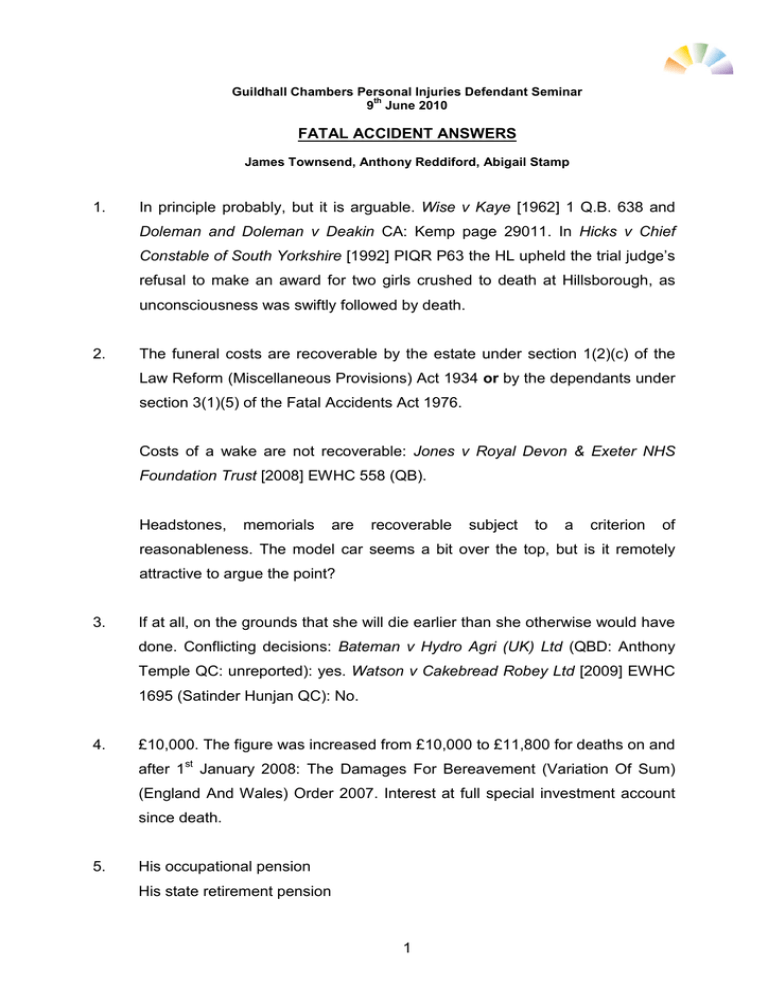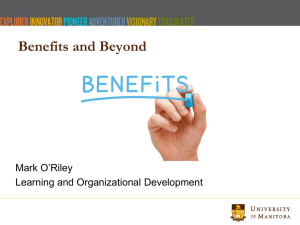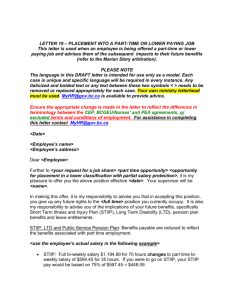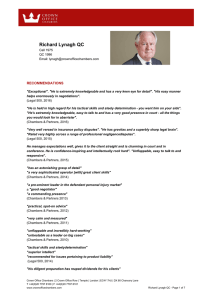1 FATAL ACCIDENT ANSWERS 1. In principle probably, but it is
advertisement

Guildhall Chambers Personal Injuries Defendant Seminar th 9 June 2010 FATAL ACCIDENT ANSWERS James Townsend, Anthony Reddiford, Abigail Stamp 1. In principle probably, but it is arguable. Wise v Kaye [1962] 1 Q.B. 638 and Doleman and Doleman v Deakin CA: Kemp page 29011. In Hicks v Chief Constable of South Yorkshire [1992] PIQR P63 the HL upheld the trial judge’s refusal to make an award for two girls crushed to death at Hillsborough, as unconsciousness was swiftly followed by death. 2. The funeral costs are recoverable by the estate under section 1(2)(c) of the Law Reform (Miscellaneous Provisions) Act 1934 or by the dependants under section 3(1)(5) of the Fatal Accidents Act 1976. Costs of a wake are not recoverable: Jones v Royal Devon & Exeter NHS Foundation Trust [2008] EWHC 558 (QB). Headstones, memorials are recoverable subject to a criterion of reasonableness. The model car seems a bit over the top, but is it remotely attractive to argue the point? 3. If at all, on the grounds that she will die earlier than she otherwise would have done. Conflicting decisions: Bateman v Hydro Agri (UK) Ltd (QBD: Anthony Temple QC: unreported): yes. Watson v Cakebread Robey Ltd [2009] EWHC 1695 (Satinder Hunjan QC): No. 4. £10,000. The figure was increased from £10,000 to £11,800 for deaths on and after 1st January 2008: The Damages For Bereavement (Variation Of Sum) (England And Wales) Order 2007. Interest at full special investment account since death. 5. His occupational pension His state retirement pension 1 Not his rental income: see Wood v Bentall Simplex Ltd [1992] PIQR P332. Cannot claim dependency on an income-yielding asset which the dependant inherits. 6. The conventional claim, based upon Harris v Empress Motors [1984] 1 WLR 212, and Coward v Comex (CA: unrep) 18/7/1988 would be: occupational pension £9,000 state pension (say) £4,500 £13,500 x 2/3 £9,000 Less £3,000 x 1/3 = £1,000 Multiplicand £8,000 There may be some argument by the Defendant, based on Cox v Hockenhull [2000] 1 WLR 750, that Mrs C’s increase in state pension on death should be deducted in the Coward calculation. In her 5 years “lost years” claim, the conventional discount would be 50%, so the multiplicand would be halved for that period. 7. (a) None. It is disregarded pursuant to s. 4 FAA, being a benefit flowing from death : Pidduck v Eastern Scottish Omnibuses Ltd [1990] 1 W.L.R. 993. (b) None. It is disregarded: Arnup v MW White Ltd [2008] EWCA Civ 447. If benefits are paid consequent upon death, they are disregarded (s. 4 FAA). If they are not consequent on death, then they are irrelevant to assessment of damages due to death. (c) 8. None. See Arnup. Calculate Mr C’s life expectancy, but for the accident. Calculate Mrs. C’s life expectancy, but for the accident. Whichever is shorter (Mr C’s as he is male 2 and women live longer), take the relevant life multiplier for that life. Discount for her mortality contingencies. Then calculate the multiplier for the last 5 years of her life and deduct that from the life multiplier, to give a split multiplier. N.B. All multipliers calculated at date of death (Cookson v Knowles [1979] AC 556 reiterated in White v Esab Group plc [2002] P.I.Q.R. Q6). 9. Vegetable production Driving Car servicing DIY/housework 10. 11. Regan v Williamson/Topp v London Country Bus; damages for loss of wife. Not within S 1 (3) (b) (ii) of FAA, which requires that unmarried couples have been living together in the same household for at least 2 years prior to death. (Cf position under the Civil Law Reform Bill) 12. Hewison v Meridian Shipping (2002) CA suggests that this type of dishonesty can bar a claim for future loss of earnings: quaere , is the position different here, where the deceased was retired? 3


